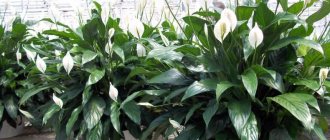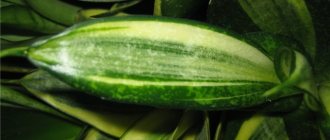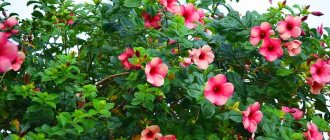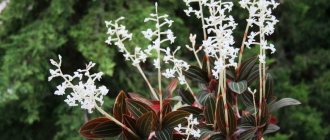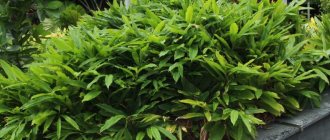Plants are a wonderful addition to home decor. However, you need to remember that all plants may require special care. They, just like pets, should never be forgotten. They need to be watered, the soil or soil changed, the ends trimmed, etc. In the same article you will learn about what care at home is required for such a beautiful plant as Sansevieria.
General rules"
If you decide to buy yourself such a wonderful new member of the household, then you should definitely know (so as not to be confused) that Sansevieria has several names. You can get to know them:
- Pike tail.
- Snake skin.
- The tongue of the devil.
- Leopard lily.
- African hemp.
- Indian sword.
- Cuckoo's tail.
- Sanseviera.
- Sansevieria.
- Sanseviera.
This number of names is definitely impressive.
Interesting! If Sansevieria appears in your home, it means it’s time to implement something you’ve been planning for a long time, since the pike tail flower symbolizes good luck.
Now you need to understand the important qualities of a houseplant that you may need to determine the proper care of sansevieria at home:
- The most valuable part of piketail as an ornamental plant is the leaves. They have a lanceolate shape and extend upward from a strong root.
- The leaves can reach a height of 1 meter, but it happens that they are even higher.
- Leaves can be of different colors. The most common colors are dark green and brown. Yellow and silvery leaves are less common.
- They may have various decorations (not in our usual understanding, of course). This can be edging and various types of stripes.
It may seem to you that these are not the most necessary facts, but every pike tail lover should also be familiar with it.
Diseases and pests of Sansevieria with photos of the affected plant. Features of care
Sansevieria is a rather unpretentious indoor plant that can tolerate even conditions that are not entirely favorable for itself.
But, sometimes, a flower is still affected by an illness, and in order to take rescue measures in time, it is necessary to understand the causes and understand the symptoms.
Read more in our article about what diseases and pests affect sansevieria, as well as ways to combat them and properly care for the flower.
What are the benefits of Sansevieria?
Surely, if you decide to take care of sansevieria at home, then you know why you need this flower. However, we decided to remind you of some beneficial properties of leopard lily:
- Natural filter for ambient air.
- If you keep it at home, you can be sure that your home will be oxygenated and free from harmful elements.
These are the most important qualities of the pike tail for which it is famous.
Important! In fact, Sansevieria is a completely unpretentious plant. In order to care for him, you only need to know a few things.
Now pay attention to some aspects of caring for sansevieria at home:
- When choosing a pot for a flower, make sure that it is thick-walled, since the roots of the plant are thick and they can easily break your pot.
- Follow the light. With a lack of light, the leaves fade, and with too much light, they turn yellow. Also, do not forget about winter supplementary lighting.
- Water the flower with rain or gently settled water. The procedure is carried out as the soil dries, less often in winter.
- Feed the plants twice in the summer.
- If possible, it is best to keep the pike tail at a temperature of 14 degrees or so. Drafts or sudden changes in temperature are strictly contraindicated.
- A good tip is to wipe the leaves of Sansevieria with a damp cloth, this will dramatically reduce the likelihood of spider mites appearing.
- To understand whether the plant has enough light, pay attention to the leaves. They always give signals. If they stretch out and droop, this is a sure sign that the plant is not receiving enough light.
- As already mentioned, you should not water sansevieria too often, otherwise the leaves will turn yellow and dry out.
These are the basic rules for caring for sansevieria at home, which must be followed constantly for the plant to feel good.
Pests: identification and destruction
Sansevieria can be affected by various pests. The most common are :
- spider mite;
- thrips;
- mealybug;
- scale insect
Spider mite
Spider mites appear as whitish spots on the leaves . The leaves turn yellow and fall off due to the fact that the pest feeds on the juices of sansevieria. The ideal conditions for the existence of spider mites are rooms with dry air and insufficient watering.
If the infection is at the initial stage, treatment of the flower is reduced to wiping its leaves with a cloth previously soaked in an infusion of citrus peel. In more severe cases, the plant is treated :
The drugs need to be alternated, as repeated treatment is less effective. The interval between treatments is 5-7 days.
Thrips
You can identify a thrips infestation by carefully examining the lower parts of the leaves. This is where colonies of thrips larvae live. On the outside of the leaf you can notice the appearance of light spots. The leaf changes its usual color to grayish-brown with a silvery sheen .
For example, if you use Actelik, then after treating the plant with Actelik solution, in the proportion of 1 ampoule per 1 liter of water, the sansevieria should be wrapped in a bag for one day to increase the effect.
Mealybug
Mealybug infestation is very easy to detect; it leaves cotton-like lumps on the leaves, which are waste products of the pest.
To carry out treatment, you need to remove the pest manually and wash the leaves with a cloth soaked in soapy water. In case of more serious damage, the plant is treated with insecticidal preparations once a week until it disappears completely.
Sansevieria transplant
Of course, one of the most important aspects of caring for sansevieria at home is replanting. The plant needs to be replanted once every 2-4 years, preferably in March-April, since usually at this time powerful roots begin to fill the entire thick-walled pot and are already beginning to protrude from its upper part. When replanting, it is necessary to take into account the composition of the soil: peat, sand, leaf soil and humus.
For those who do not perceive such information well in printed form and often forget various nuances, you can use a video that will clearly show you how to carry out this simple procedure.
How to propagate Sansevieria at home
Reproduction is possible by dividing rhizomes, leaves or lateral shoots, as well as seeds.
When dividing the rhizome, it is cut with a sharp knife so that each part has its own growing point. Plant each fragment in a separate pot and place it in a warm place, providing moderate watering.
When dividing a leaf, you need to divide it into parts 4-5 cm long, hold them in the air for a short time and place the lower end of each in sand (at an angle of 45°). Next, you need to cover each fragment with a bottle or jar and place it in a warm and bright place without direct sunlight.
When watering, water is poured into the pan. After 30-40 days, as soon as the sansevieria has been rooted and buds have appeared, it can be transplanted into a container with soil. This method is not suitable for variegated species, since with this method of propagation they lose their decorative stripes and grow monochromatic.
You can also separate a shoot from the main stem and place it in water. After about a month, roots will form and the seedling can be planted in the ground.
If, at the end of flowering, you see shoots similar to dill on the ground near the plant, you can collect the seeds and sow them in the ground . No need to sprinkle. Shoots will appear in 10-15 days. You can pick them up after 1 month.
Bloom
Many people who want to buy a pike tail have a question: does this beautiful plant even bloom? In fact, Sansevieria rarely blooms, but there are special conditions that help the plant bloom. They have already been mentioned above, but I would like to pay special attention to some.
Firstly, it is good lighting, but do not forget that excess light will also not be the best option for favorable flowering of the plant. Secondly, this is proper care, that is, compliance with all the rules that were described above. Thirdly, fresh air, but remember that drafts harm the pike tail.
For flowering to occur, window sills of southern, western and eastern orientation are best suited. In winter, light can be compensated by “additional illumination,” that is, artificially created illumination.
If you want to understand how to determine whether a plant is blooming or not, then pay attention to whether your plant has sent out an oblong arrow. The small flowers that accompany the flowering of Sansevieria look simply charming against the background of dark green leaves.
They resemble a lily flower. This is probably why Sansevieria has the name “leopard” lily. They smell delicious, but their smell will not be intrusive, it is light and gentle. Mostly flowers bloom in the dark. Most often, the plant blooms in the warm season, mainly in the summer.
Note! With proper care and good lighting, the plant can begin to bloom even in the spring, in April or May.
But each rosette can bloom only once in its entire life. Intense flowering lasts for five to seven days.
General rules of care
The optimal temperature in summer is +20 +27 degrees, in winter +10 +18.- The plant prefers diffused light and easily tolerates partial shade.
- Sansevieria is watered moderately from spring to autumn, and in winter it is limited to once every two to three weeks, and the leaves must be wiped from dust with a slightly damp cloth regularly.
- Air humidity is not an important criterion for a plant, but still, it is better to avoid over-humidification of the air, especially in combination with high temperatures, as this can provoke rotting processes.
- During the active growing season, it is necessary to fertilize once a month.
It is easier to prevent any disease of a plant than to take emergency measures to treat and save it, so the symptoms of various ailments and the methods used to restore the health of a flower are valuable information for every lover of indoor plants.
If you find an error, please select a piece of text and press Ctrl+Enter.
Plant species
In addition to the fact that this plant goes by many names and names, it also has many different species. Depending on what exactly you want to purchase, you choose for yourself which flower will bloom in your home, enrich your air, saturate the house with oxygen.
Types of Sansevieria:
- Sansevieria Three-striped , also known as Laurenti. A very large plant. It was mentioned above that Sansevieria grows up to a meter or more. So, it is Laurenti who usually grows above a meter. But on average her height is from thirty to sixty meters. Its leaflet is flat and sword-shaped. The rosette is formed from six powerful, striped leaves. Lighting has a special influence on the color of leaves. The more the plant receives it, the brighter its longitudinal stripes on the leaves. You can find this type of pike tail in offices, kindergartens, schools and other government and children's institutions.
- Nelson . Formed (hybrid) from the above described Laurenti species. The leaves of this type are thick and, like many others, dark green. Their length is generally 20-30 cm. Most of all they are known for their density of growth. However, Nelson is growing extremely slowly.
- Compacta . Small Laurenti is called compact. Almost completely matches the appearance of its ancestor, only smaller in size (about 30 cm).
- Cylindrical . This type of sansvieria can rarely be found in homes, as it is considered very exotic and is distinguished by its beauty. Height is from 40 to 150 cm. Its peculiarity is that it is absolutely unpretentious to lighting. The leaves have natural flexibility. Despite the fact that she herself is unpretentious to light, flowering occurs with sufficient lighting.
- Pickaxe . Its leaves resemble shells or ruffles. They are covered with abundant speckles, their color is green or slightly brownish (pinkish). When it blooms, it emits a wonderful delicate aroma. Captivates everyone and attracts everyone's attention
- Liberian . The leaves of this species are arranged horizontally, which greatly distinguishes this type of Sansevieria from others in which the leaves are directed upward.
- Graceful (graceful) . The houseplant resembles an agave.
In addition to these main seven species, there are others that you can find much less frequently: Duneri, Hyacinth, Big, Moonshine, Hunny, Hunny Gold, Hunny Silver, Sensation Bentle, Futura, Robusta, Silver Queen, Twisted Sister.
Possible diseases of mother-in-law's tongue
Pike tail is quite resistant to diseases, so even novice gardeners successfully grow it. The appearance of spots is most likely due to the peculiarities of care; when they are eliminated, the plant retains its beautiful appearance.
Most often, the appearance of leaf spotting is associated with abundant watering and low ambient temperatures. Leaves can become soft and brittle if there is not enough sunlight. Curling leaves indicate a lack of moisture.
The leaves of the flower turn yellow
The yellow color of the leaves of mother-in-law's tongue indicates improperly organized care; it is worth checking the following parameters:
Mother-in-law's tongue is suitable even for novice gardeners. The plant is resistant to disease, easy to care for, and has a presentable appearance. If you follow basic care recommendations, it will please the owners for many years. Breeders claim that after the appearance of white-green flowers on a long peduncle in the spring-summer period, it leads to the fulfillment of the most cherished desires, success in financial affairs comes, peace reigns in the family, and a white streak begins.
Source


